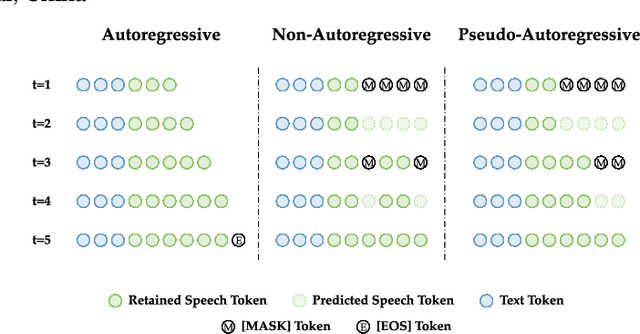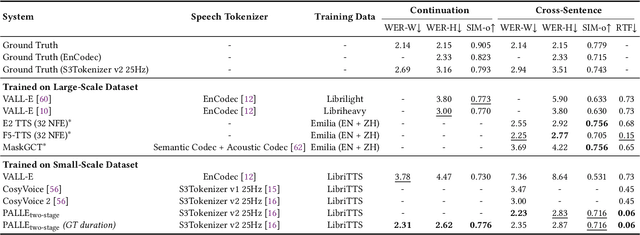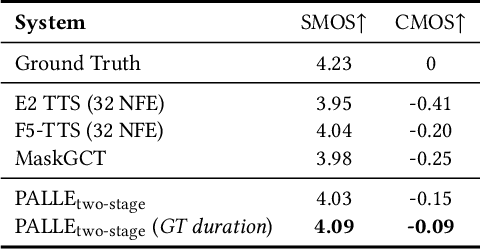Yuxuan Hu
MathCanvas: Intrinsic Visual Chain-of-Thought for Multimodal Mathematical Reasoning
Oct 16, 2025Abstract:While Large Language Models (LLMs) have excelled in textual reasoning, they struggle with mathematical domains like geometry that intrinsically rely on visual aids. Existing approaches to Visual Chain-of-Thought (VCoT) are often limited by rigid external tools or fail to generate the high-fidelity, strategically-timed diagrams necessary for complex problem-solving. To bridge this gap, we introduce MathCanvas, a comprehensive framework designed to endow unified Large Multimodal Models (LMMs) with intrinsic VCoT capabilities for mathematics. Our approach consists of two phases. First, a Visual Manipulation stage pre-trains the model on a novel 15.2M-pair corpus, comprising 10M caption-to-diagram pairs (MathCanvas-Imagen) and 5.2M step-by-step editing trajectories (MathCanvas-Edit), to master diagram generation and editing. Second, a Strategic Visual-Aided Reasoning stage fine-tunes the model on MathCanvas-Instruct, a new 219K-example dataset of interleaved visual-textual reasoning paths, teaching it when and how to leverage visual aids. To facilitate rigorous evaluation, we introduce MathCanvas-Bench, a challenging benchmark with 3K problems that require models to produce interleaved visual-textual solutions. Our model, BAGEL-Canvas, trained under this framework, achieves an 86% relative improvement over strong LMM baselines on MathCanvas-Bench, demonstrating excellent generalization to other public math benchmarks. Our work provides a complete toolkit-framework, datasets, and benchmark-to unlock complex, human-like visual-aided reasoning in LMMs. Project Page: https://mathcanvas.github.io/
PeftCD: Leveraging Vision Foundation Models with Parameter-Efficient Fine-Tuning for Remote Sensing Change Detection
Sep 11, 2025Abstract:To tackle the prevalence of pseudo changes, the scarcity of labeled samples, and the difficulty of cross-domain generalization in multi-temporal and multi-source remote sensing imagery, we propose PeftCD, a change detection framework built upon Vision Foundation Models (VFMs) with Parameter-Efficient Fine-Tuning (PEFT). At its core, PeftCD employs a weight-sharing Siamese encoder derived from a VFM, into which LoRA and Adapter modules are seamlessly integrated. This design enables highly efficient task adaptation by training only a minimal set of additional parameters. To fully unlock the potential of VFMs, we investigate two leading backbones: the Segment Anything Model v2 (SAM2), renowned for its strong segmentation priors, and DINOv3, a state-of-the-art self-supervised representation learner. The framework is complemented by a deliberately lightweight decoder, ensuring the focus remains on the powerful feature representations from the backbones. Extensive experiments demonstrate that PeftCD achieves state-of-the-art performance across multiple public datasets, including SYSU-CD (IoU 73.81%), WHUCD (92.05%), MSRSCD (64.07%), MLCD (76.89%), CDD (97.01%), S2Looking (52.25%) and LEVIR-CD (85.62%), with notably precise boundary delineation and strong suppression of pseudo-changes. In summary, PeftCD presents an optimal balance of accuracy, efficiency, and generalization. It offers a powerful and scalable paradigm for adapting large-scale VFMs to real-world remote sensing change detection applications. The code and pretrained models will be released at https://github.com/dyzy41/PeftCD.
LongEmotion: Measuring Emotional Intelligence of Large Language Models in Long-Context Interaction
Sep 09, 2025Abstract:Large language models (LLMs) make significant progress in Emotional Intelligence (EI) and long-context understanding. However, existing benchmarks tend to overlook certain aspects of EI in long-context scenarios, especially under realistic, practical settings where interactions are lengthy, diverse, and often noisy. To move towards such realistic settings, we present LongEmotion, a benchmark specifically designed for long-context EI tasks. It covers a diverse set of tasks, including Emotion Classification, Emotion Detection, Emotion QA, Emotion Conversation, Emotion Summary, and Emotion Expression. On average, the input length for these tasks reaches 8,777 tokens, with long-form generation required for Emotion Expression. To enhance performance under realistic constraints, we incorporate Retrieval-Augmented Generation (RAG) and Collaborative Emotional Modeling (CoEM), and compare them with standard prompt-based methods. Unlike conventional approaches, our RAG method leverages both the conversation context and the large language model itself as retrieval sources, avoiding reliance on external knowledge bases. The CoEM method further improves performance by decomposing the task into five stages, integrating both retrieval augmentation and limited knowledge injection. Experimental results show that both RAG and CoEM consistently enhance EI-related performance across most long-context tasks, advancing LLMs toward more practical and real-world EI applications. Furthermore, we conducted a comparative case study experiment on the GPT series to demonstrate the differences among various models in terms of EI. Code is available on GitHub at https://github.com/LongEmotion/LongEmotion, and the project page can be found at https://longemotion.github.io/.
Towards Efficient Speech-Text Jointly Decoding within One Speech Language Model
Jun 04, 2025Abstract:Speech language models (Speech LMs) enable end-to-end speech-text modelling within a single model, offering a promising direction for spoken dialogue systems. The choice of speech-text jointly decoding paradigm plays a critical role in performance, efficiency, and alignment quality. In this work, we systematically compare representative joint speech-text decoding strategies-including the interleaved, and parallel generation paradigms-under a controlled experimental setup using the same base language model, speech tokenizer and training data. Our results show that the interleaved approach achieves the best alignment. However it suffers from slow inference due to long token sequence length. To address this, we propose a novel early-stop interleaved (ESI) pattern that not only significantly accelerates decoding but also yields slightly better performance. Additionally, we curate high-quality question answering (QA) datasets to further improve speech QA performance.
Phi-Omni-ST: A multimodal language model for direct speech-to-speech translation
Jun 04, 2025Abstract:Speech-aware language models (LMs) have demonstrated capabilities in understanding spoken language while generating text-based responses. However, enabling them to produce speech output efficiently and effectively remains a challenge. In this paper, we present Phi-Omni-ST, a multimodal LM for direct speech-to-speech translation (ST), built on the open-source Phi-4 MM model. Phi-Omni-ST extends its predecessor by generating translated speech using an audio transformer head that predicts audio tokens with a delay relative to text tokens, followed by a streaming vocoder for waveform synthesis. Our experimental results on the CVSS-C dataset demonstrate Phi-Omni-ST's superior performance, significantly surpassing existing baseline models trained on the same dataset. Furthermore, when we scale up the training data and the model size, Phi-Omni-ST reaches on-par performance with the current SOTA model.
MEGADance: Mixture-of-Experts Architecture for Genre-Aware 3D Dance Generation
May 23, 2025Abstract:Music-driven 3D dance generation has attracted increasing attention in recent years, with promising applications in choreography, virtual reality, and creative content creation. Previous research has generated promising realistic dance movement from audio signals. However, traditional methods underutilize genre conditioning, often treating it as auxiliary modifiers rather than core semantic drivers. This oversight compromises music-motion synchronization and disrupts dance genre continuity, particularly during complex rhythmic transitions, thereby leading to visually unsatisfactory effects. To address the challenge, we propose MEGADance, a novel architecture for music-driven 3D dance generation. By decoupling choreographic consistency into dance generality and genre specificity, MEGADance demonstrates significant dance quality and strong genre controllability. It consists of two stages: (1) High-Fidelity Dance Quantization Stage (HFDQ), which encodes dance motions into a latent representation by Finite Scalar Quantization (FSQ) and reconstructs them with kinematic-dynamic constraints, and (2) Genre-Aware Dance Generation Stage (GADG), which maps music into the latent representation by synergistic utilization of Mixture-of-Experts (MoE) mechanism with Mamba-Transformer hybrid backbone. Extensive experiments on the FineDance and AIST++ dataset demonstrate the state-of-the-art performance of MEGADance both qualitatively and quantitatively. Code will be released upon acceptance.
MatchDance: Collaborative Mamba-Transformer Architecture Matching for High-Quality 3D Dance Synthesis
May 21, 2025Abstract:Music-to-dance generation represents a challenging yet pivotal task at the intersection of choreography, virtual reality, and creative content generation. Despite its significance, existing methods face substantial limitation in achieving choreographic consistency. To address the challenge, we propose MatchDance, a novel framework for music-to-dance generation that constructs a latent representation to enhance choreographic consistency. MatchDance employs a two-stage design: (1) a Kinematic-Dynamic-based Quantization Stage (KDQS), which encodes dance motions into a latent representation by Finite Scalar Quantization (FSQ) with kinematic-dynamic constraints and reconstructs them with high fidelity, and (2) a Hybrid Music-to-Dance Generation Stage(HMDGS), which uses a Mamba-Transformer hybrid architecture to map music into the latent representation, followed by the KDQS decoder to generate 3D dance motions. Additionally, a music-dance retrieval framework and comprehensive metrics are introduced for evaluation. Extensive experiments on the FineDance dataset demonstrate state-of-the-art performance. Code will be released upon acceptance.
Pseudo-Autoregressive Neural Codec Language Models for Efficient Zero-Shot Text-to-Speech Synthesis
Apr 14, 2025



Abstract:Recent zero-shot text-to-speech (TTS) systems face a common dilemma: autoregressive (AR) models suffer from slow generation and lack duration controllability, while non-autoregressive (NAR) models lack temporal modeling and typically require complex designs. In this paper, we introduce a novel pseudo-autoregressive (PAR) codec language modeling approach that unifies AR and NAR modeling. Combining explicit temporal modeling from AR with parallel generation from NAR, PAR generates dynamic-length spans at fixed time steps. Building on PAR, we propose PALLE, a two-stage TTS system that leverages PAR for initial generation followed by NAR refinement. In the first stage, PAR progressively generates speech tokens along the time dimension, with each step predicting all positions in parallel but only retaining the left-most span. In the second stage, low-confidence tokens are iteratively refined in parallel, leveraging the global contextual information. Experiments demonstrate that PALLE, trained on LibriTTS, outperforms state-of-the-art systems trained on large-scale data, including F5-TTS, E2-TTS, and MaskGCT, on the LibriSpeech test-clean set in terms of speech quality, speaker similarity, and intelligibility, while achieving up to ten times faster inference speed. Audio samples are available at https://anonymous-palle.github.io.
QUAD: Quantization and Parameter-Efficient Tuning of LLM with Activation Decomposition
Mar 25, 2025Abstract:Large Language Models (LLMs) excel in diverse applications but suffer inefficiency due to massive scale. While quantization reduces computational costs, existing methods degrade accuracy in medium-sized LLMs (e.g., Llama-3-8B) due to activation outliers. To address this, we propose QUAD (Quantization with Activation Decomposition), a framework leveraging Singular Value Decomposition (SVD) to suppress activation outliers for effective 4-bit quantization. QUAD estimates activation singular vectors offline using calibration data to construct an orthogonal transformation matrix P, shifting outliers to additional dimensions in full precision while quantizing rest components to 4-bit. Additionally, QUAD enables parameter-efficient fine-tuning via adaptable full-precision outlier weights, narrowing the accuracy gap between quantized and full-precision models. Experiments demonstrate that QUAD achieves 94% ~ 96% accuracy under W4A4 quantization and 98% accuracy with W4A4/A8 and parameter-efficient fine-tuning for Llama-3 and Qwen-2.5 models. Our code is available at \href{https://github.com/hyx1999/Quad}{repository}.
Phi-4-Mini Technical Report: Compact yet Powerful Multimodal Language Models via Mixture-of-LoRAs
Mar 03, 2025Abstract:We introduce Phi-4-Mini and Phi-4-Multimodal, compact yet highly capable language and multimodal models. Phi-4-Mini is a 3.8-billion-parameter language model trained on high-quality web and synthetic data, significantly outperforming recent open-source models of similar size and matching the performance of models twice its size on math and coding tasks requiring complex reasoning. This achievement is driven by a carefully curated synthetic data recipe emphasizing high-quality math and coding datasets. Compared to its predecessor, Phi-3.5-Mini, Phi-4-Mini features an expanded vocabulary size of 200K tokens to better support multilingual applications, as well as group query attention for more efficient long-sequence generation. Phi-4-Multimodal is a multimodal model that integrates text, vision, and speech/audio input modalities into a single model. Its novel modality extension approach leverages LoRA adapters and modality-specific routers to allow multiple inference modes combining various modalities without interference. For example, it now ranks first in the OpenASR leaderboard to date, although the LoRA component of the speech/audio modality has just 460 million parameters. Phi-4-Multimodal supports scenarios involving (vision + language), (vision + speech), and (speech/audio) inputs, outperforming larger vision-language and speech-language models on a wide range of tasks. Additionally, we experiment to further train Phi-4-Mini to enhance its reasoning capabilities. Despite its compact 3.8-billion-parameter size, this experimental version achieves reasoning performance on par with or surpassing significantly larger models, including DeepSeek-R1-Distill-Qwen-7B and DeepSeek-R1-Distill-Llama-8B.
 Add to Chrome
Add to Chrome Add to Firefox
Add to Firefox Add to Edge
Add to Edge